MGMT 302 Report: Overcoming Challenges for Women Leaders
VerifiedAdded on 2023/04/21
|7
|1538
|354
Report
AI Summary
This report examines the persistent challenges faced by women in the workplace, including the glass ceiling, gender pay gaps, and various forms of discrimination. It highlights the legislative efforts made to address these issues and explores the role of Human Resource Management (HRM) in implementing solutions such as flexible working hours, leadership training, and creating a supportive environment for women's advancement. The report also discusses emerging trends aimed at increasing the representation of women in executive positions and ensuring equal opportunities for women from diverse ethnic backgrounds. It emphasizes the importance of addressing workplace safety concerns and implementing performance-based promotion systems to foster trust and motivation among women employees. Desklib offers additional resources, including past papers and solved assignments, to further explore this topic.
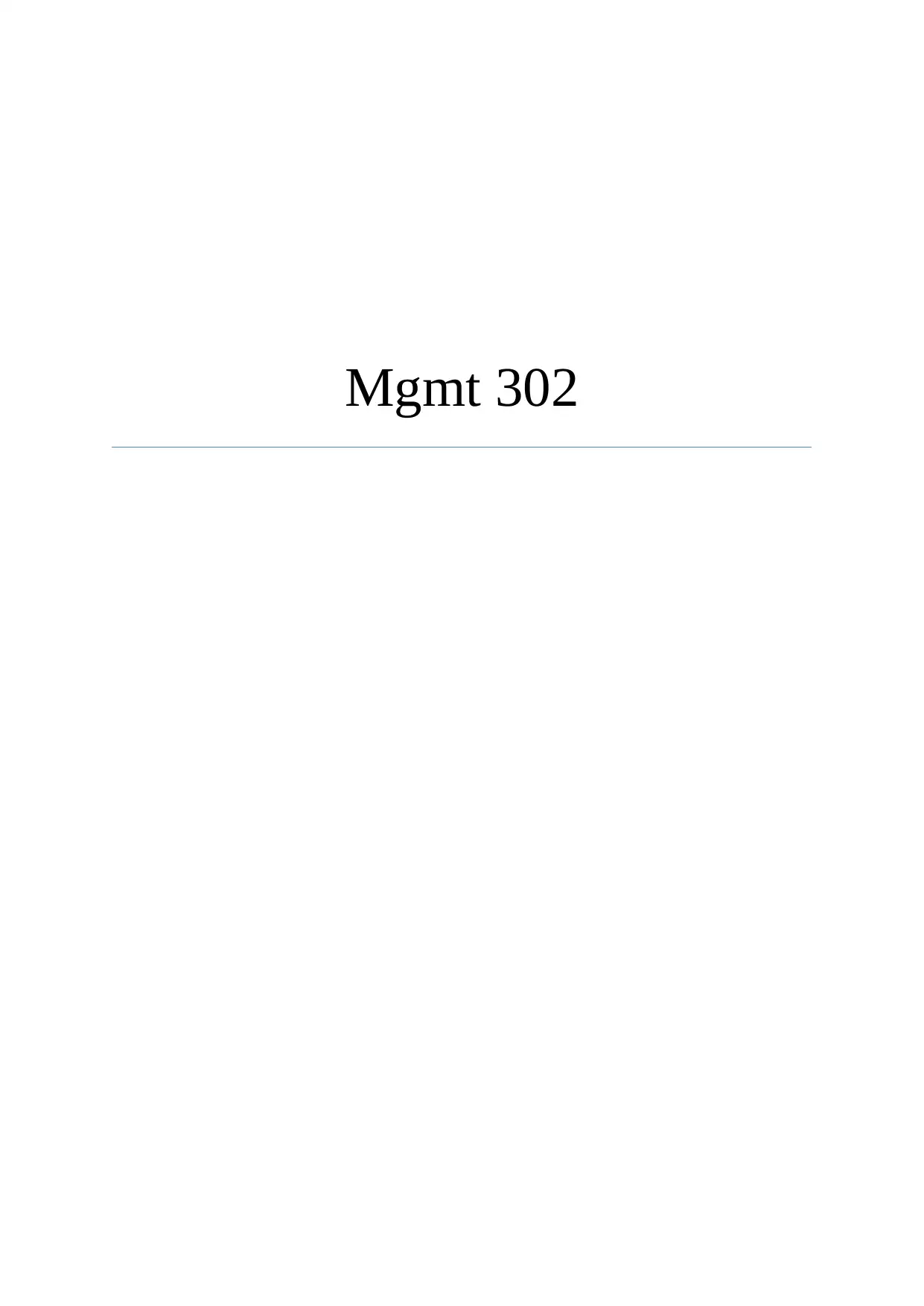
Mgmt 302
Paraphrase This Document
Need a fresh take? Get an instant paraphrase of this document with our AI Paraphraser

1
Contents
Introduction...........................................................................................................................................1
Issues faced by women..........................................................................................................................1
Legislations towards this issue..............................................................................................................2
Things that are done by HRM to counter these issues..........................................................................2
Trends moving forward.........................................................................................................................2
Conclusion.............................................................................................................................................3
REFERENCES......................................................................................................................................4
Contents
Introduction...........................................................................................................................................1
Issues faced by women..........................................................................................................................1
Legislations towards this issue..............................................................................................................2
Things that are done by HRM to counter these issues..........................................................................2
Trends moving forward.........................................................................................................................2
Conclusion.............................................................................................................................................3
REFERENCES......................................................................................................................................4
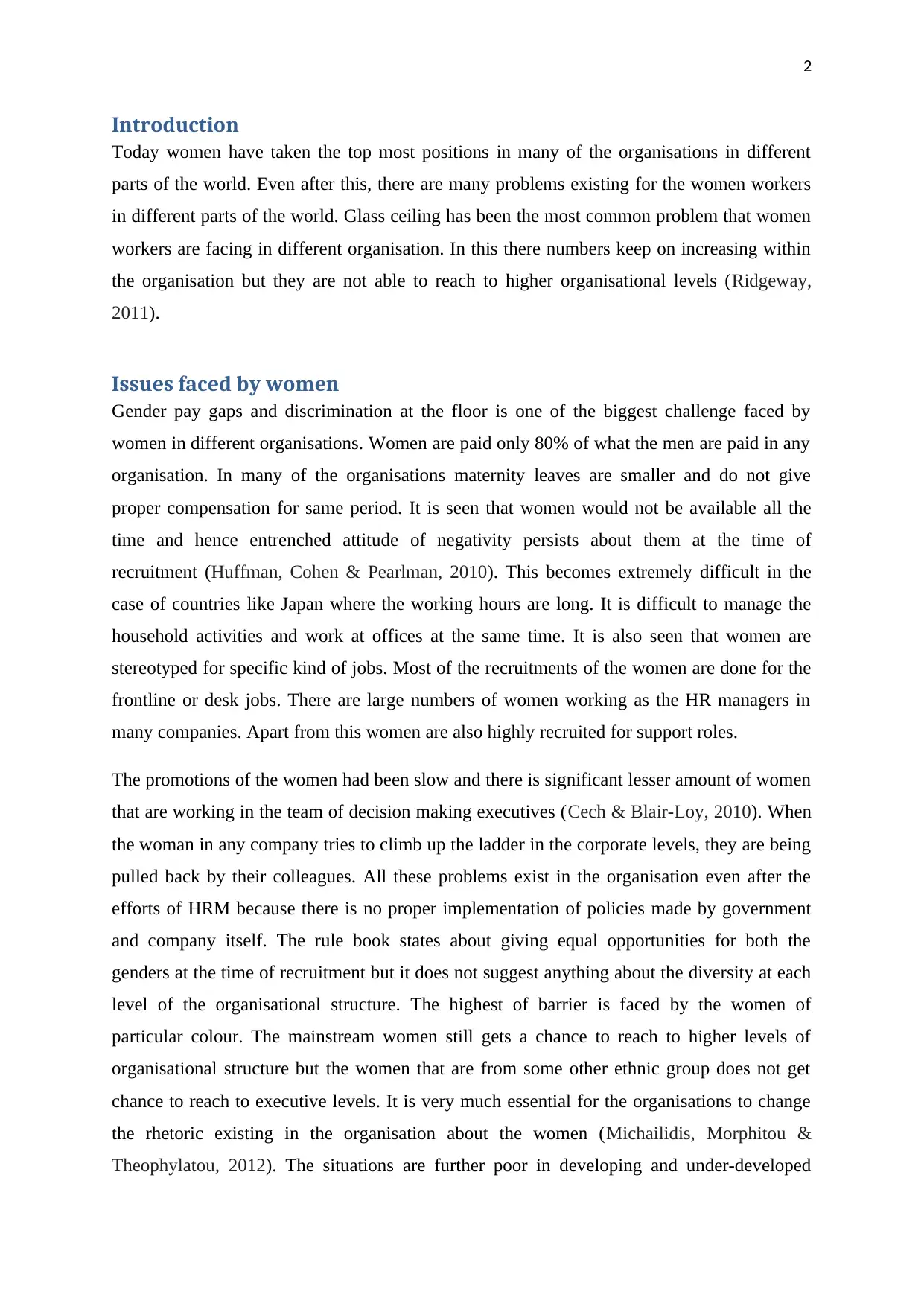
2
Introduction
Today women have taken the top most positions in many of the organisations in different
parts of the world. Even after this, there are many problems existing for the women workers
in different parts of the world. Glass ceiling has been the most common problem that women
workers are facing in different organisation. In this there numbers keep on increasing within
the organisation but they are not able to reach to higher organisational levels (Ridgeway,
2011).
Issues faced by women
Gender pay gaps and discrimination at the floor is one of the biggest challenge faced by
women in different organisations. Women are paid only 80% of what the men are paid in any
organisation. In many of the organisations maternity leaves are smaller and do not give
proper compensation for same period. It is seen that women would not be available all the
time and hence entrenched attitude of negativity persists about them at the time of
recruitment (Huffman, Cohen & Pearlman, 2010). This becomes extremely difficult in the
case of countries like Japan where the working hours are long. It is difficult to manage the
household activities and work at offices at the same time. It is also seen that women are
stereotyped for specific kind of jobs. Most of the recruitments of the women are done for the
frontline or desk jobs. There are large numbers of women working as the HR managers in
many companies. Apart from this women are also highly recruited for support roles.
The promotions of the women had been slow and there is significant lesser amount of women
that are working in the team of decision making executives (Cech & Blair-Loy, 2010). When
the woman in any company tries to climb up the ladder in the corporate levels, they are being
pulled back by their colleagues. All these problems exist in the organisation even after the
efforts of HRM because there is no proper implementation of policies made by government
and company itself. The rule book states about giving equal opportunities for both the
genders at the time of recruitment but it does not suggest anything about the diversity at each
level of the organisational structure. The highest of barrier is faced by the women of
particular colour. The mainstream women still gets a chance to reach to higher levels of
organisational structure but the women that are from some other ethnic group does not get
chance to reach to executive levels. It is very much essential for the organisations to change
the rhetoric existing in the organisation about the women (Michailidis, Morphitou &
Theophylatou, 2012). The situations are further poor in developing and under-developed
Introduction
Today women have taken the top most positions in many of the organisations in different
parts of the world. Even after this, there are many problems existing for the women workers
in different parts of the world. Glass ceiling has been the most common problem that women
workers are facing in different organisation. In this there numbers keep on increasing within
the organisation but they are not able to reach to higher organisational levels (Ridgeway,
2011).
Issues faced by women
Gender pay gaps and discrimination at the floor is one of the biggest challenge faced by
women in different organisations. Women are paid only 80% of what the men are paid in any
organisation. In many of the organisations maternity leaves are smaller and do not give
proper compensation for same period. It is seen that women would not be available all the
time and hence entrenched attitude of negativity persists about them at the time of
recruitment (Huffman, Cohen & Pearlman, 2010). This becomes extremely difficult in the
case of countries like Japan where the working hours are long. It is difficult to manage the
household activities and work at offices at the same time. It is also seen that women are
stereotyped for specific kind of jobs. Most of the recruitments of the women are done for the
frontline or desk jobs. There are large numbers of women working as the HR managers in
many companies. Apart from this women are also highly recruited for support roles.
The promotions of the women had been slow and there is significant lesser amount of women
that are working in the team of decision making executives (Cech & Blair-Loy, 2010). When
the woman in any company tries to climb up the ladder in the corporate levels, they are being
pulled back by their colleagues. All these problems exist in the organisation even after the
efforts of HRM because there is no proper implementation of policies made by government
and company itself. The rule book states about giving equal opportunities for both the
genders at the time of recruitment but it does not suggest anything about the diversity at each
level of the organisational structure. The highest of barrier is faced by the women of
particular colour. The mainstream women still gets a chance to reach to higher levels of
organisational structure but the women that are from some other ethnic group does not get
chance to reach to executive levels. It is very much essential for the organisations to change
the rhetoric existing in the organisation about the women (Michailidis, Morphitou &
Theophylatou, 2012). The situations are further poor in developing and under-developed
⊘ This is a preview!⊘
Do you want full access?
Subscribe today to unlock all pages.

Trusted by 1+ million students worldwide
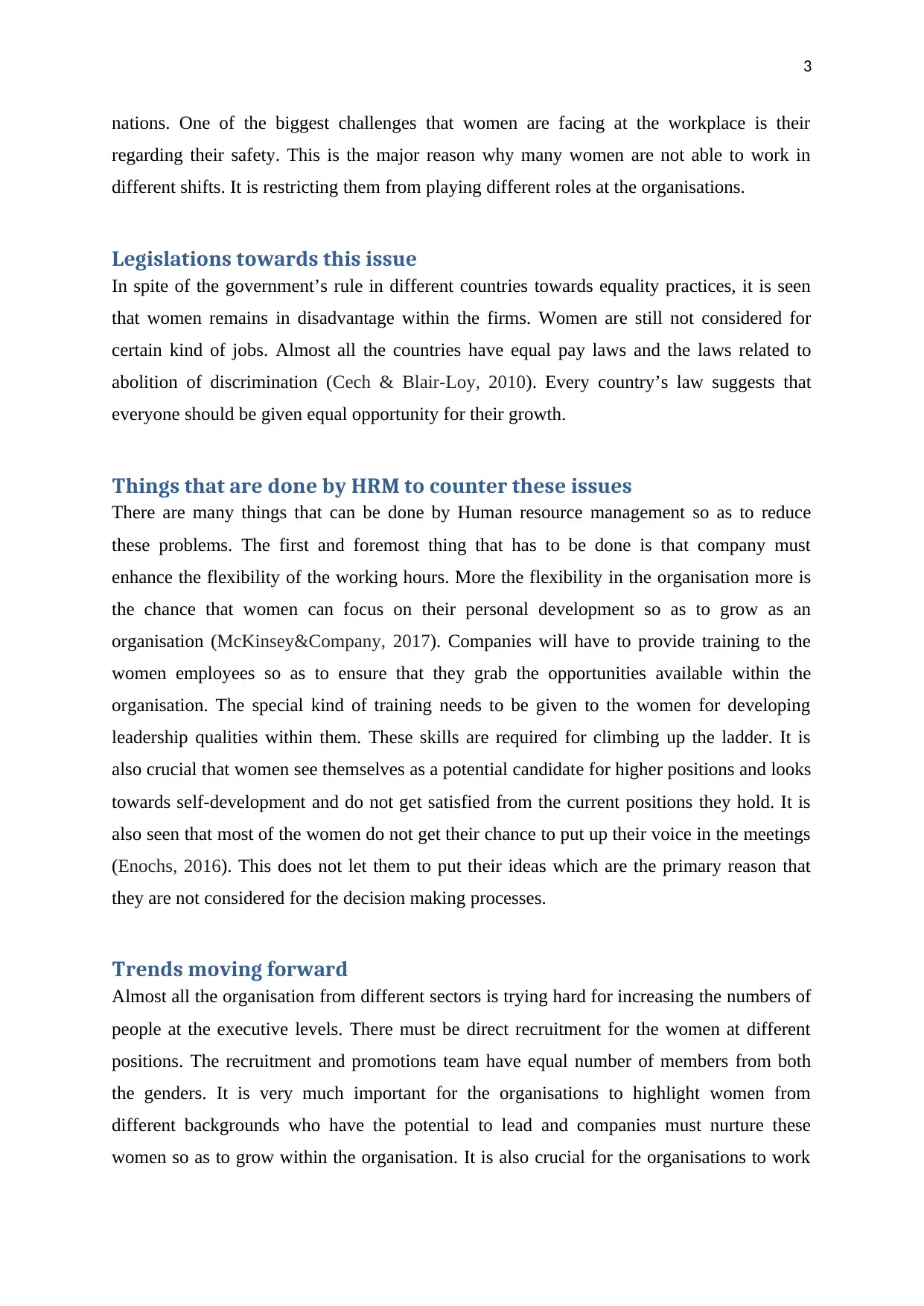
3
nations. One of the biggest challenges that women are facing at the workplace is their
regarding their safety. This is the major reason why many women are not able to work in
different shifts. It is restricting them from playing different roles at the organisations.
Legislations towards this issue
In spite of the government’s rule in different countries towards equality practices, it is seen
that women remains in disadvantage within the firms. Women are still not considered for
certain kind of jobs. Almost all the countries have equal pay laws and the laws related to
abolition of discrimination (Cech & Blair-Loy, 2010). Every country’s law suggests that
everyone should be given equal opportunity for their growth.
Things that are done by HRM to counter these issues
There are many things that can be done by Human resource management so as to reduce
these problems. The first and foremost thing that has to be done is that company must
enhance the flexibility of the working hours. More the flexibility in the organisation more is
the chance that women can focus on their personal development so as to grow as an
organisation (McKinsey&Company, 2017). Companies will have to provide training to the
women employees so as to ensure that they grab the opportunities available within the
organisation. The special kind of training needs to be given to the women for developing
leadership qualities within them. These skills are required for climbing up the ladder. It is
also crucial that women see themselves as a potential candidate for higher positions and looks
towards self-development and do not get satisfied from the current positions they hold. It is
also seen that most of the women do not get their chance to put up their voice in the meetings
(Enochs, 2016). This does not let them to put their ideas which are the primary reason that
they are not considered for the decision making processes.
Trends moving forward
Almost all the organisation from different sectors is trying hard for increasing the numbers of
people at the executive levels. There must be direct recruitment for the women at different
positions. The recruitment and promotions team have equal number of members from both
the genders. It is very much important for the organisations to highlight women from
different backgrounds who have the potential to lead and companies must nurture these
women so as to grow within the organisation. It is also crucial for the organisations to work
nations. One of the biggest challenges that women are facing at the workplace is their
regarding their safety. This is the major reason why many women are not able to work in
different shifts. It is restricting them from playing different roles at the organisations.
Legislations towards this issue
In spite of the government’s rule in different countries towards equality practices, it is seen
that women remains in disadvantage within the firms. Women are still not considered for
certain kind of jobs. Almost all the countries have equal pay laws and the laws related to
abolition of discrimination (Cech & Blair-Loy, 2010). Every country’s law suggests that
everyone should be given equal opportunity for their growth.
Things that are done by HRM to counter these issues
There are many things that can be done by Human resource management so as to reduce
these problems. The first and foremost thing that has to be done is that company must
enhance the flexibility of the working hours. More the flexibility in the organisation more is
the chance that women can focus on their personal development so as to grow as an
organisation (McKinsey&Company, 2017). Companies will have to provide training to the
women employees so as to ensure that they grab the opportunities available within the
organisation. The special kind of training needs to be given to the women for developing
leadership qualities within them. These skills are required for climbing up the ladder. It is
also crucial that women see themselves as a potential candidate for higher positions and looks
towards self-development and do not get satisfied from the current positions they hold. It is
also seen that most of the women do not get their chance to put up their voice in the meetings
(Enochs, 2016). This does not let them to put their ideas which are the primary reason that
they are not considered for the decision making processes.
Trends moving forward
Almost all the organisation from different sectors is trying hard for increasing the numbers of
people at the executive levels. There must be direct recruitment for the women at different
positions. The recruitment and promotions team have equal number of members from both
the genders. It is very much important for the organisations to highlight women from
different backgrounds who have the potential to lead and companies must nurture these
women so as to grow within the organisation. It is also crucial for the organisations to work
Paraphrase This Document
Need a fresh take? Get an instant paraphrase of this document with our AI Paraphraser
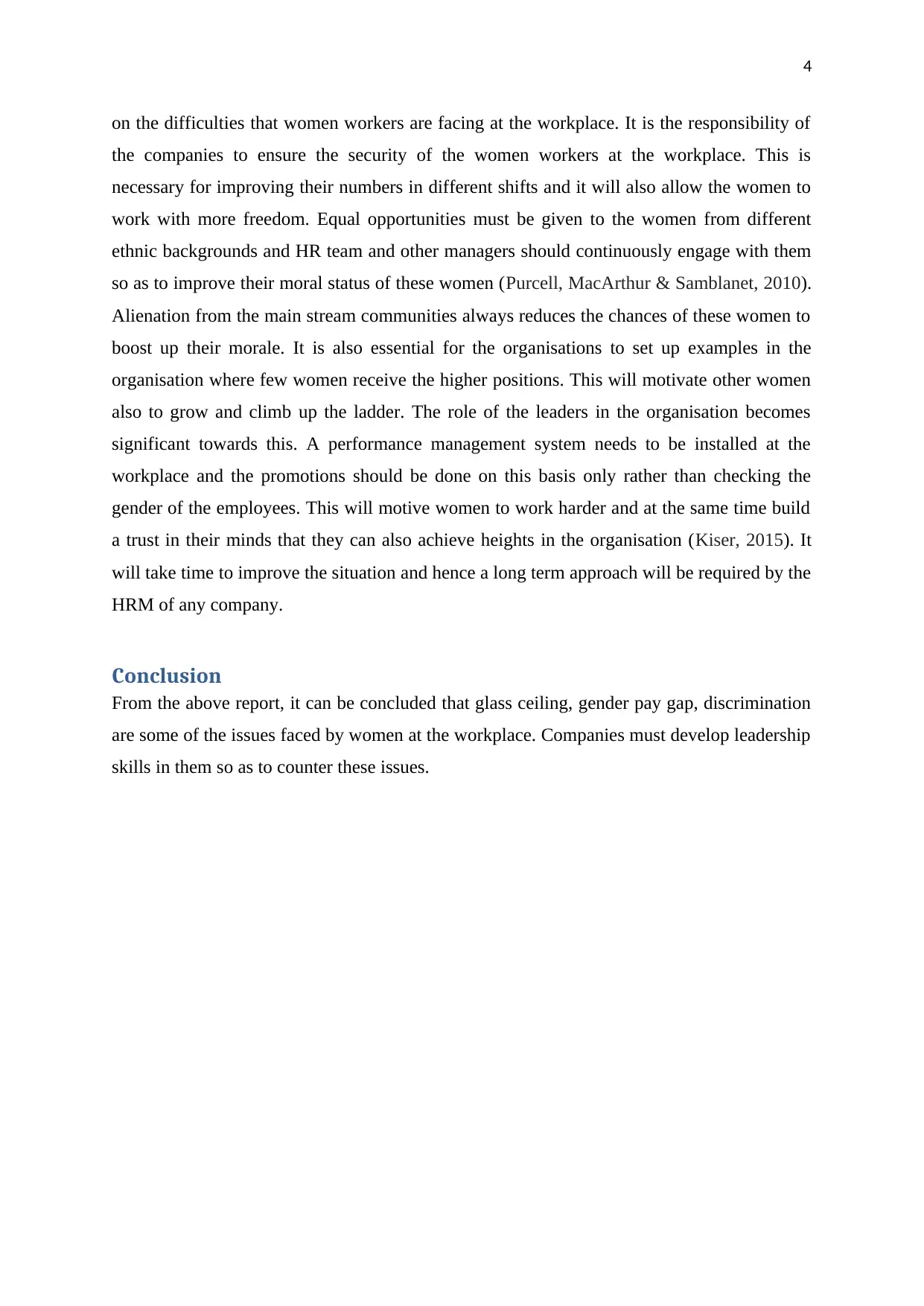
4
on the difficulties that women workers are facing at the workplace. It is the responsibility of
the companies to ensure the security of the women workers at the workplace. This is
necessary for improving their numbers in different shifts and it will also allow the women to
work with more freedom. Equal opportunities must be given to the women from different
ethnic backgrounds and HR team and other managers should continuously engage with them
so as to improve their moral status of these women (Purcell, MacArthur & Samblanet, 2010).
Alienation from the main stream communities always reduces the chances of these women to
boost up their morale. It is also essential for the organisations to set up examples in the
organisation where few women receive the higher positions. This will motivate other women
also to grow and climb up the ladder. The role of the leaders in the organisation becomes
significant towards this. A performance management system needs to be installed at the
workplace and the promotions should be done on this basis only rather than checking the
gender of the employees. This will motive women to work harder and at the same time build
a trust in their minds that they can also achieve heights in the organisation (Kiser, 2015). It
will take time to improve the situation and hence a long term approach will be required by the
HRM of any company.
Conclusion
From the above report, it can be concluded that glass ceiling, gender pay gap, discrimination
are some of the issues faced by women at the workplace. Companies must develop leadership
skills in them so as to counter these issues.
on the difficulties that women workers are facing at the workplace. It is the responsibility of
the companies to ensure the security of the women workers at the workplace. This is
necessary for improving their numbers in different shifts and it will also allow the women to
work with more freedom. Equal opportunities must be given to the women from different
ethnic backgrounds and HR team and other managers should continuously engage with them
so as to improve their moral status of these women (Purcell, MacArthur & Samblanet, 2010).
Alienation from the main stream communities always reduces the chances of these women to
boost up their morale. It is also essential for the organisations to set up examples in the
organisation where few women receive the higher positions. This will motivate other women
also to grow and climb up the ladder. The role of the leaders in the organisation becomes
significant towards this. A performance management system needs to be installed at the
workplace and the promotions should be done on this basis only rather than checking the
gender of the employees. This will motive women to work harder and at the same time build
a trust in their minds that they can also achieve heights in the organisation (Kiser, 2015). It
will take time to improve the situation and hence a long term approach will be required by the
HRM of any company.
Conclusion
From the above report, it can be concluded that glass ceiling, gender pay gap, discrimination
are some of the issues faced by women at the workplace. Companies must develop leadership
skills in them so as to counter these issues.
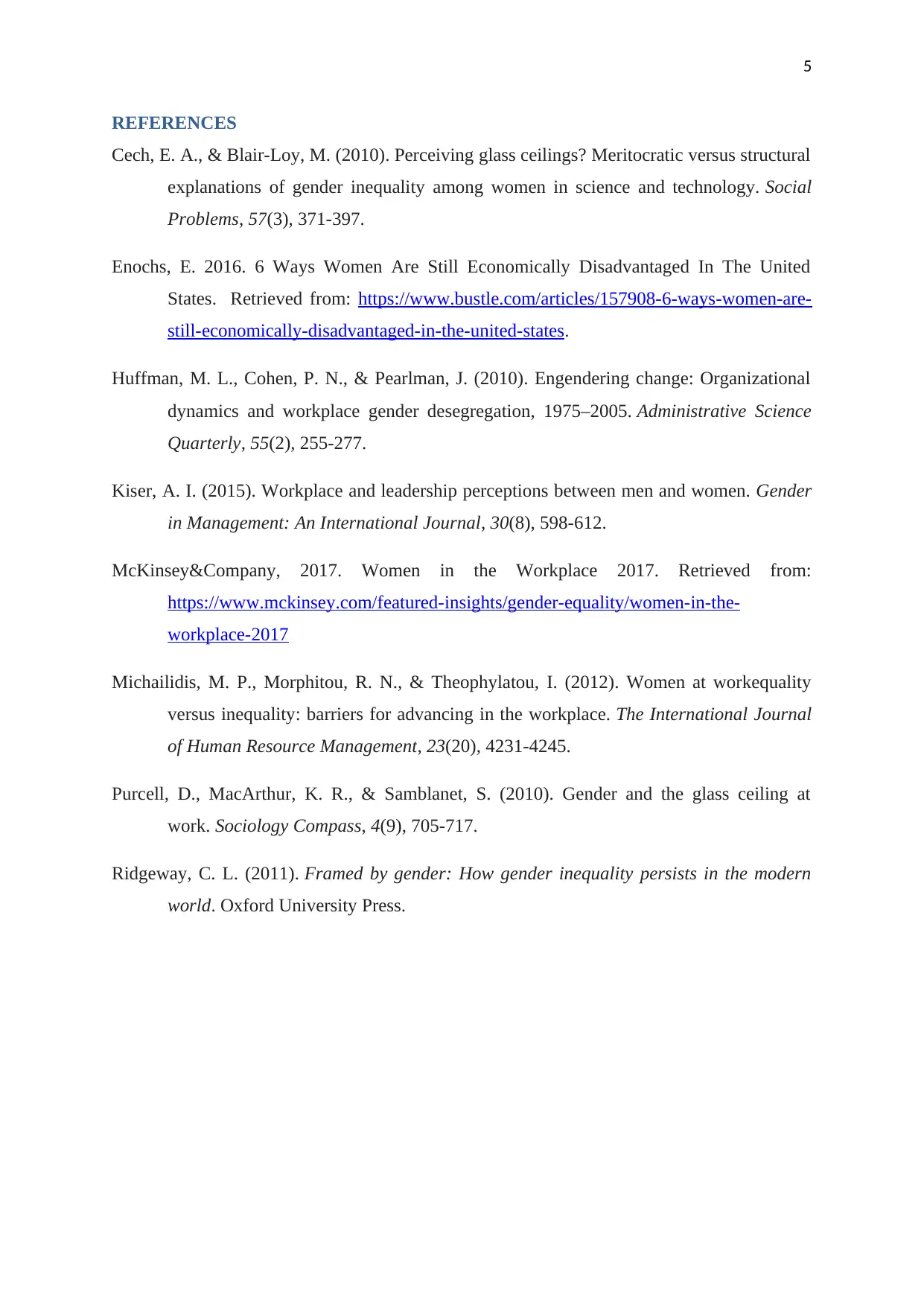
5
REFERENCES
Cech, E. A., & Blair-Loy, M. (2010). Perceiving glass ceilings? Meritocratic versus structural
explanations of gender inequality among women in science and technology. Social
Problems, 57(3), 371-397.
Enochs, E. 2016. 6 Ways Women Are Still Economically Disadvantaged In The United
States. Retrieved from: https://www.bustle.com/articles/157908-6-ways-women-are-
still-economically-disadvantaged-in-the-united-states.
Huffman, M. L., Cohen, P. N., & Pearlman, J. (2010). Engendering change: Organizational
dynamics and workplace gender desegregation, 1975–2005. Administrative Science
Quarterly, 55(2), 255-277.
Kiser, A. I. (2015). Workplace and leadership perceptions between men and women. Gender
in Management: An International Journal, 30(8), 598-612.
McKinsey&Company, 2017. Women in the Workplace 2017. Retrieved from:
https://www.mckinsey.com/featured-insights/gender-equality/women-in-the-
workplace-2017
Michailidis, M. P., Morphitou, R. N., & Theophylatou, I. (2012). Women at workequality
versus inequality: barriers for advancing in the workplace. The International Journal
of Human Resource Management, 23(20), 4231-4245.
Purcell, D., MacArthur, K. R., & Samblanet, S. (2010). Gender and the glass ceiling at
work. Sociology Compass, 4(9), 705-717.
Ridgeway, C. L. (2011). Framed by gender: How gender inequality persists in the modern
world. Oxford University Press.
REFERENCES
Cech, E. A., & Blair-Loy, M. (2010). Perceiving glass ceilings? Meritocratic versus structural
explanations of gender inequality among women in science and technology. Social
Problems, 57(3), 371-397.
Enochs, E. 2016. 6 Ways Women Are Still Economically Disadvantaged In The United
States. Retrieved from: https://www.bustle.com/articles/157908-6-ways-women-are-
still-economically-disadvantaged-in-the-united-states.
Huffman, M. L., Cohen, P. N., & Pearlman, J. (2010). Engendering change: Organizational
dynamics and workplace gender desegregation, 1975–2005. Administrative Science
Quarterly, 55(2), 255-277.
Kiser, A. I. (2015). Workplace and leadership perceptions between men and women. Gender
in Management: An International Journal, 30(8), 598-612.
McKinsey&Company, 2017. Women in the Workplace 2017. Retrieved from:
https://www.mckinsey.com/featured-insights/gender-equality/women-in-the-
workplace-2017
Michailidis, M. P., Morphitou, R. N., & Theophylatou, I. (2012). Women at workequality
versus inequality: barriers for advancing in the workplace. The International Journal
of Human Resource Management, 23(20), 4231-4245.
Purcell, D., MacArthur, K. R., & Samblanet, S. (2010). Gender and the glass ceiling at
work. Sociology Compass, 4(9), 705-717.
Ridgeway, C. L. (2011). Framed by gender: How gender inequality persists in the modern
world. Oxford University Press.
⊘ This is a preview!⊘
Do you want full access?
Subscribe today to unlock all pages.

Trusted by 1+ million students worldwide

6
1 out of 7
Related Documents
Your All-in-One AI-Powered Toolkit for Academic Success.
+13062052269
info@desklib.com
Available 24*7 on WhatsApp / Email
![[object Object]](/_next/static/media/star-bottom.7253800d.svg)
Unlock your academic potential
Copyright © 2020–2025 A2Z Services. All Rights Reserved. Developed and managed by ZUCOL.





